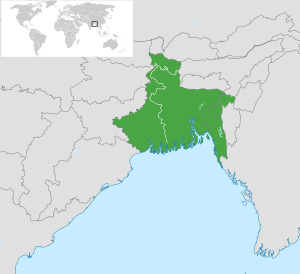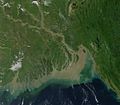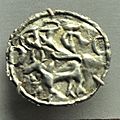Bengal facts for kids
Bengal is a special area in South Asia. It is now divided between two countries: Bangladesh and India. Long ago, this whole area was one. It was even part of British India for a while. Today, the western part is called West Bengal and belongs to India. The eastern part, once known as East Bengal, is now the country of Bangladesh.
Contents
What is Bengal?
Bengal is a large and important region. It is known for its rich history and vibrant culture. The area is mostly flat, with many rivers flowing through it. The biggest rivers are the Ganges and the Brahmaputra. They create a huge delta, which is one of the largest in the world. This delta is very fertile, meaning it's great for farming.
Where is Bengal Located?
Bengal is in the eastern part of South Asia. It touches the Bay of Bengal to the south. To the north, you can sometimes see the snowy peaks of the Himalayas. The region shares borders with other parts of India and Myanmar. Its location has made it a center for trade and travel for centuries.
People and Culture
Most people in Bengal speak Bengali. It is one of the most spoken languages globally. The people of Bengal are called Bengalis. They have a unique culture with their own music, dance, and food.
Rich Traditions and Arts
Bengali culture is famous for its literature and arts. For example, Rabindranath Tagore was a famous Bengali writer. He even won the Nobel Prize. Traditional music, like Baul ballads, is also very popular. These songs tell stories and are recognized by UNESCO. Bengali food is also well-known, especially its delicious fish and rice dishes.
Festivals and Celebrations
People in Bengal celebrate many festivals. These often involve colorful parades and special foods. They are a big part of community life.
A Look at History
Bengal has a very long and interesting history. It was home to powerful kingdoms and empires.
Ancient Times
In ancient times, Bengal was known as Gangaridai. This name was even mentioned in old Greek writings. Later, powerful empires like the Pala Empire ruled the region. They helped spread art and learning.
The Sultanate Era
From the 14th to the 16th centuries, Bengal was ruled by sultans. This period was known as the Bengal Sultanate. It was a time of great growth in trade and architecture. Many beautiful mosques and buildings were built then. Bengal became a major trading hub.
British Rule and Division
In the 18th century, the British took control of Bengal. This marked the start of British India. The Battle of Plassey in 1757 was a key event. It led to British power growing in the region. For a long time, Bengal was a very important part of British India.
In 1947, when India became independent, Bengal was divided. The western part became West Bengal in India. The eastern part became East Pakistan.
Birth of Bangladesh
East Pakistan later fought for its independence. This led to the Bangladesh Liberation War in 1971. After a brave struggle, East Pakistan became the independent country of Bangladesh. Leaders like Sheikh Mujibur Rahman played a big role in this.
Modern Bengal
Today, both West Bengal and Bangladesh are growing. They have busy cities and important ports. Kolkata is a major city in West Bengal. Dhaka is the capital of Bangladesh. Both parts of Bengal continue to share their rich cultural heritage.
Related pages
Images for kids
-
On a clear day, the snowy peaks of the Himalayas in Nepal and Sikkim can be seen from northern Bangladesh and Darjeeling district of West Bengal
-
Waterfalls are a common sight in the highlands of eastern Bangladesh
-
Cox's Bazar has the longest uninterrupted sea beach in the world
-
A 2015 census of Sundarbans Bengal tigers found 106 in Bangladesh and 76 in West Bengal.
-
Inscriptions on the Adina Mosque proclaim the builder Sikandar Shah as "the wisest, the most just, the most perfect and most liberal of the Sultans of Arabia, Persia and India."
-
A woman in Dhaka clad in fine Bengali muslin, 18th century.
-
The Battle of Plassey in 1757 ushered British rule
-
The former royal palace of Hill Tippera in Agartala
-
Shaheed Minar in Dhaka commemorates the 1952 Language Movement
-
Sheikh Mujibur Rahman led Bengali's decade long independence struggle including the Bangladesh Liberation War of 1971
-
The Victoria Memorial in Kolkata, India
-
The strategically important city of Chittagong is home to the busiest port on the Bay of Bengal
-
Rabindranath Tagore, known as the Bengali Shakespeare, being hosted at the Parliament of Iran in the 1930s
-
Bungalows originated from Bengali architecture
-
A sculpture on Fazlur Rahman Khan at the Sears Tower in the United States
-
A Baul musician. The Baul ballads of Bengal are classified by UNESCO as humanity's intangible cultural heritage
-
A river in Bangladesh
-
A mustard and date palm farm in West Bengal
-
A tea garden in Bangladesh
-
Kanchenjunga from Singalila National Park, West Bengal
-
Gangaridai in Ptolemy's map, 1st century
-
The Pala Empire, 9th century
-
At its greatest extent, the Bengal Sultanate's realm and protectorates stretched from Jaunpur in North India in the west to Tripura and Arakan in the east
-
The Bengal Sultanate, 16th century
-
Bengal & Bihar in 1776 by James Rennell
-
Colonial Bengal, 19th century
-
Flag of Bengal Sultanate
See also
 In Spanish: Bengala para niños
In Spanish: Bengala para niños





































